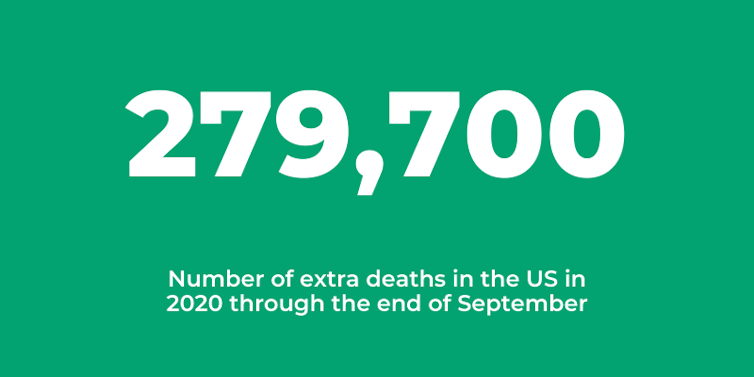279,700 extra deaths in the US so far in this pandemic year

A girl views the body of her father, who died of COVID-19, while mourners who can’t visit in person are onscreen. Joe Raedle/Getty Images News via Getty Images
Courtesy of Ronald D. Fricker Jr., Virginia Tech
The Conversation, CC BY-ND
The number of deaths in the United States through September 2020 is at least 10% and likely 13% higher than it would have been if the coronavirus pandemic had never happened, according to Centers for Disease Control and Prevention data. Conservatively, that’s at least 224,173 deaths and probably as many as 279,700 deaths above what was expected, just for the first nine months of the year. That’s 24,000 to 79,000 extra fatalities above the number of deaths attributed to COVID-19.
Tracking deaths
When someone dies, the death certificate records an immediate cause of death, along with up to three underlying conditions that “initiated the events resulting in death.” The certificate is filed with the local health department, and the details are reported to the National Center for Health Statistics.
As part of the National Vital Statistics System, the National Center for Health Statistics then uses this information in various ways, such as tabulating the leading causes of death in the United States. Currently, heart disease is the leading cause of death, followed by cancer. COVID-19 is now the third-largest cause of death for 2020.
Projecting from the past
To calculate excess deaths requires a comparison to what would have occurred if COVID-19 had not existed. Obviously, it’s not possible to observe what didn’t happen, but it is possible to estimate it using historical data. The CDC does this using a statistical model based on the previous three years of mortality data, incorporating seasonal trends as well as adjustments for data-reporting delays.
So, looking at what happened over the past three years, the CDC projects what might have been. By using a statistical model, they are also able to calculate the uncertainty in their estimates. That allows statisticians like me to assess whether the observed number of deaths looks unusual compared to what we expect to see.
The number of excess deaths is the difference between the model’s projections and the actual observations. Through September, that gives 279,700 deaths above what was expected. The CDC also calculates an upper threshold for the estimated number of deaths to help determine when the observed number of deaths is unquestionably high compared to historical trends. Even using that threshold as a very conservative standard means there were at least 224,173 excess deaths.
Clearly visible in a graph of this data is the spike in deaths beginning in mid-March 2020 and continuing to the present. You can also see another period of excess deaths from December 2017 to January 2018, attributable to an unusually virulent flu strain that season.
The magnitude of the excess deaths in 2020 makes clear that COVID-19 is much worse than influenza, even when compared to a bad flu year like 2017-18, when an estimated 61,000 people in the U.S. died of the illness.
The large spike in deaths in April 2020 corresponds to the coronavirus outbreak in the Northeast, after which the number of excess deaths decreased regularly and substantially until July, when it started to increase again. That uptick in excess deaths is attributable to the outbreaks in the South and West that occurred over the summer.
The data tell the story
It doesn’t take a sophisticated statistical model to see that the coronavirus pandemic is causing substantially more deaths than would have otherwise occurred. Mortality in 2020 is clearly different from the previous years’ regular patterns, with substantial increases and unusual trends.
The number of deaths the CDC officially attributed to COVID-19 in the United States was 200,499 through Oct. 3.
Some people who are skeptical about the impact of the coronavirus suggest these deaths would have occurred anyway, perhaps because COVID-19 is particularly deadly for the elderly. Others believe that, because the pandemic has changed life so drastically, the increase in COVID-19-related deaths is probably offset by decreases from other causes. But neither of these theories is true.
In fact, the number of excess deaths in the U.S. currently exceeds the number attributable to COVID-19 by at least 23,674 and likely up to 79,201. What’s behind those additional deaths is not yet clear. It could be that COVID-19 deaths are being undercounted, or the pandemic could also be causing an increasing number of deaths due to other causes. What we are starting to learn is that it is probably some of both.
A recent study in the Journal of the American Medical Association found that COVID-19 was documented as a cause of death in 67% of excess deaths between March and July in the U.S. But the researchers also identified increased mortality rates due to heart disease, as well as two spikes for deaths related to Alzheimer’s disease/dementia. Some people are delaying medical treatments for fear of getting infected with the coronavirus.
Another JAMA study found that the 2020 excess death rate is higher in the U.S. than in other countries hard-hit by COVID-19. That difference is likely the result of multiple factors, including inconsistent public health guidance, a decentralized and sometimes conflicting governmental response, and disruptions triggered by the pandemic.
Regardless of the reasons, this pandemic has resulted in substantially more deaths than would have otherwise occurred – and it is not over yet.
This is an updated version of an article originally published on Aug. 13, 2020.![]()
Ronald D. Fricker Jr., Professor of Statistics and Associate Dean for Faculty Affairs and Administration, Virginia Tech
This article is republished from The Conversation under a Creative Commons license. Read the original article.




